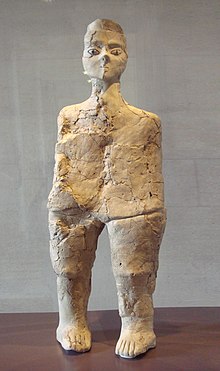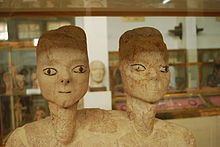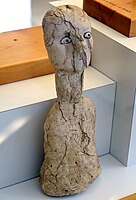安加扎勒雕像:修订间差异
Mrmarkertw(留言 | 贡献) 标签:2017年版源代码编辑 |
补救7个来源,并将0个来源标记为失效。) #IABot (v2.0.9.3 |
||
| 第38行: | 第38行: | ||
}} |
}} |
||
}} |
}} |
||
'''安加扎勒雕像'''({{lang-en|ʿAin Ghazal statues}})是一些大型的[[石灰]]泥和[[蘆葦]][[塑像|雕像]],發現於[[约旦]]的{{link-en|安加扎勒|ʿAin_Ghazal}}考古遺址,該雕像可以追溯到約9000年前(公元前7200年<ref>{{cite book|author=Ben-Nissan, Besim|url=https://books.google.com/books?id=Gmm4BAAAQBAJ&pg=PA436|title=Advances in Calcium Phosphate Biomaterials|date=17 April 2014|publisher=Springer Science & Business|isbn=9783642539800|page=436|access-date=5 July 2016}}</ref>至公元前6250年之間<ref>{{Cite web|title=Ain Ghazal {{!}} Description, Culture, Significance, & Facts {{!}} Britannica|url=https://www.britannica.com/place/Ain-Ghazal|access-date=2021-11-17|website=www.britannica.com|language=en}}</ref>),屬於{{link-en|前陶器時代|Pre-Pottery_Neolithic}}C期。1983年和1985年,考古學家們在該遺址兩個地下儲藏室中,發現了總共15個雕像和15個胸像,這兩個儲藏室的設立年代相距約200年。<ref>{{cite book|last=McCarter|first=Susan|title=Neolithic|pages=161–163|publisher= |
'''安加扎勒雕像'''({{lang-en|ʿAin Ghazal statues}})是一些大型的[[石灰]]泥和[[蘆葦]][[塑像|雕像]],發現於[[约旦]]的{{link-en|安加扎勒|ʿAin_Ghazal}}考古遺址,該雕像可以追溯到約9000年前(公元前7200年<ref>{{cite book|author=Ben-Nissan, Besim|url=https://books.google.com/books?id=Gmm4BAAAQBAJ&pg=PA436|title=Advances in Calcium Phosphate Biomaterials|date=17 April 2014|publisher=Springer Science & Business|isbn=9783642539800|page=436|access-date=5 July 2016}}</ref>至公元前6250年之間<ref>{{Cite web|title=Ain Ghazal {{!}} Description, Culture, Significance, & Facts {{!}} Britannica|url=https://www.britannica.com/place/Ain-Ghazal|access-date=2021-11-17|website=www.britannica.com|language=en|archive-date=2022-11-24|archive-url=https://web.archive.org/web/20221124105514/https://www.britannica.com/place/Ain-Ghazal|dead-url=no}}</ref>),屬於{{link-en|前陶器時代|Pre-Pottery_Neolithic}}C期。1983年和1985年,考古學家們在該遺址兩個地下儲藏室中,發現了總共15個雕像和15個胸像,這兩個儲藏室的設立年代相距約200年。<ref>{{cite book|last=McCarter|first=Susan|title=Neolithic|pages=161–163|publisher=Routledge|date=12 November 2012|isbn=9781134220397|url=https://books.google.com/books?id=dKDfRMNpsmYC&pg=PA161|access-date=20 June 2016}} |
||
G. O. Rollefson in: Ian Kuijt (ed.), ''Life in Neolithic Farming Communities: Social Organization, Identity, and Differentiation'', Springer (2006), [https://books.google.com/books?id=2D8OBwAAQBAJ&pg=PA153 p. 153].</ref> |
G. O. Rollefson in: Ian Kuijt (ed.), ''Life in Neolithic Farming Communities: Social Organization, Identity, and Differentiation'', Springer (2006), [https://books.google.com/books?id=2D8OBwAAQBAJ&pg=PA153 p. 153] {{Wayback|url=https://books.google.com/books?id=2D8OBwAAQBAJ&pg=PA153 |date=20230321083813 }}.</ref> |
||
安加扎勒雕像視為是人類形象最早的大型代表之一,被認為是前陶器時代B或C期史前藝術中最出色的雕像古物之一。<ref name=aingazal>{{cite web|title=Lime Plaster statues|work=British Museum|publisher=Trustees of the British Museum|url= https://www.britishmuseum.org/explore/highlights/highlight_objects/me/l/lime_plaster_statues.aspx|access-date=21 September 2015|archive-url=https://web.archive.org/web/20151018143147/http://www.britishmuseum.org/explore/highlights/highlight_objects/me/l/lime_plaster_statues.aspx|archive-date=18 October 2015}}安加扎勒雕像雕像中最高的大約有1公尺高,它們被認為是獨立站立,雖然它們需要以地面為支撐,否則無法支撐自身重量。上古石器時代的[[维纳斯小像]]通常不到20厘米高。來自舊石器時代的人形雕像,如[[勞塞爾的維納斯]],更高則為[[浅浮雕]]或繪畫形式。 |archive-date=18 October 2015}}</ref>儘管該雕像的製造目的仍然不確定,考古學家們認為它們可能在製作後立即被埋葬,可能是有意為之。<ref name="McCarter163" /><ref name=Feldman>{{cite web|last1=Feldman|first1=Keffie|title=Ain-Ghazal (Jordan) Pre-pottery Neolithic B Period pit of lime plaster human figures|publisher=Joukowsky Institute, Brown University|quote=他們通常被認為是社區中祖先的代表,或是對此主題的變化。這個觀點可以基於這些雕像頭部和分離的掩膜頭骨的相似處理方式而得出。雕像的埋葬方式也類似於安加扎勒人埋葬死者的方式。然而,如果這些雕像根本不是代表,而是本身就是有生命力的物體呢?如果它們被埋葬的方式類似於人類,因為人們認為它們已經死亡或失去了生命力?這些雕像帶來了同樣多的問題和答案,因此將成為未來研究的豐富資源。|url= |
安加扎勒雕像視為是人類形象最早的大型代表之一,被認為是前陶器時代B或C期史前藝術中最出色的雕像古物之一。<ref name=aingazal>{{cite web|title=Lime Plaster statues|work=British Museum|publisher=Trustees of the British Museum|url= https://www.britishmuseum.org/explore/highlights/highlight_objects/me/l/lime_plaster_statues.aspx|access-date=21 September 2015|archive-url=https://web.archive.org/web/20151018143147/http://www.britishmuseum.org/explore/highlights/highlight_objects/me/l/lime_plaster_statues.aspx|archive-date=18 October 2015}}安加扎勒雕像雕像中最高的大約有1公尺高,它們被認為是獨立站立,雖然它們需要以地面為支撐,否則無法支撐自身重量。上古石器時代的[[维纳斯小像]]通常不到20厘米高。來自舊石器時代的人形雕像,如[[勞塞爾的維納斯]],更高則為[[浅浮雕]]或繪畫形式。 |archive-date=18 October 2015}}</ref>儘管該雕像的製造目的仍然不確定,考古學家們認為它們可能在製作後立即被埋葬,可能是有意為之。<ref name="McCarter163" /><ref name=Feldman>{{cite web|last1=Feldman|first1=Keffie|title=Ain-Ghazal (Jordan) Pre-pottery Neolithic B Period pit of lime plaster human figures|publisher=Joukowsky Institute, Brown University|quote=他們通常被認為是社區中祖先的代表,或是對此主題的變化。這個觀點可以基於這些雕像頭部和分離的掩膜頭骨的相似處理方式而得出。雕像的埋葬方式也類似於安加扎勒人埋葬死者的方式。然而,如果這些雕像根本不是代表,而是本身就是有生命力的物體呢?如果它們被埋葬的方式類似於人類,因為人們認為它們已經死亡或失去了生命力?這些雕像帶來了同樣多的問題和答案,因此將成為未來研究的豐富資源。|url=https://www.brown.edu/Departments/Joukowsky_Institute/courses/architecturebodyperformance/326.html|access-date=16 June 2018|archive-date=2020-12-05|archive-url=https://web.archive.org/web/20201205125813/https://www.brown.edu/Departments/Joukowsky_Institute/courses/architecturebodyperformance/326.html|dead-url=no}}</ref> |
||
安加扎勒雕像現在大量保存位於[[安曼]]的[[約旦博物館]],部分雕像也在[[約旦考古博物館]]展出,而一些雕像被借給外國博物館保存。一個雕像現在在[[巴黎]]的[[羅浮宮]]展出;其他三個雕像可以在[[倫敦]]的[[大英博物馆]]看到<ref>{{Cite web|title=British Museum, London, United Kingdom — Google Arts & Culture|url= |
安加扎勒雕像現在大量保存位於[[安曼]]的[[約旦博物館]],部分雕像也在[[約旦考古博物館]]展出,而一些雕像被借給外國博物館保存。一個雕像現在在[[巴黎]]的[[羅浮宮]]展出;其他三個雕像可以在[[倫敦]]的[[大英博物馆]]看到<ref>{{Cite web|title=British Museum, London, United Kingdom — Google Arts & Culture|url=https://artsandculture.google.com/streetview/british-museum/AwEp68JO4NECkQ?sv_h=316.4182620279755&sv_p=-8.067471856963579&sv_pid=FBMkuaIhF9L-wVvBKWVQjA&sv_lid=3582009757710443819&sv_lng=-0.1278856906070018&sv_lat=51.51957185414885&sv_z=0.6911292499459274|access-date=2021-09-09|website=artsandculture.google.com|archive-date=2023-03-21|archive-url=https://web.archive.org/web/20230321083808/https://artsandculture.google.com/streetview/british-museum/AwEp68JO4NECkQ?sv_h=316.4182620279755&sv_p=-8.067471856963579&sv_pid=FBMkuaIhF9L-wVvBKWVQjA&sv_lid=3582009757710443819&sv_lng=-0.1278856906070018&sv_lat=51.51957185414885&sv_z=0.6911292499459274|dead-url=no}}</ref>;一個帶有兩個頭的雕像現在在[[阿布扎比]]的[[阿布達比羅浮宮]]展出。<ref name=":0">{{cite web|title=East meets West as Louvre Abu Dhabi opens in the Gulf|author=Carvalho, Stanley|work=[[Reuters]]|access-date=2019-11-15|date=2017-11-07|url=https://www.reuters.com/article/us-emirates-louvre/east-meets-west-as-louvre-abu-dhabi-opens-in-the-gulf-idUSKBN1D719F|archive-date=2022-03-12|archive-url=https://web.archive.org/web/20220312015303/https://www.reuters.com/article/us-emirates-louvre/east-meets-west-as-louvre-abu-dhabi-opens-in-the-gulf-idUSKBN1D719F|dead-url=no}}</ref><ref name=":1">{{Cite web|title=The First Villages {{!}} Gallery 1|website=Louvre Abu Dhabi|url=https://www.louvreabudhabi.ae/en/Explore/museum-galleries/gallery-1|access-date=2021-09-04|archive-date=2022-11-24|archive-url=https://web.archive.org/web/20221124105518/https://www.louvreabudhabi.ae/en/Explore/museum-galleries/gallery-1|dead-url=no}}</ref> |
||
==描述== |
==描述== |
||
| 第65行: | 第65行: | ||
</ref> |
</ref> |
||
隨後,發現雕像的坑洞被小心翼翼地挖掘出來,然後將雕像放置在一個填充聚氨酯泡沫以保護運輸的木盒中保存。<ref name=wjoc>{{cite web|title=Preserving Ancient Statues from Jordan (1996-1997 exhibition )|publisher=Arthur M. Sackler Gallery & Freer Gallery of Art, [[Smithsonian Institution]], Washington, D.C.|url= http://www.asia.si.edu/jordan/html/textonly.htm|access-date=20 June 2016|archive-url=https://web.archive.org/web/20010220131933/http://www.asia.si.edu/jordan/html/textonly.htm|url-status=dead|archive-date=20 February 2001}}</ref>在遺址上發現的第一組雕像隨後被送往英國{{link-en|皇家考古研究所|Royal Archaeological Institute}},而第二組雕像則在幾年後被發現,送往紐約史密森尼学会進行修復工作。經過修復後,大部分雕像歸還到約旦,並在約旦博物館進行展示。<ref>{{cite book|last=Kafafi|first=Zeidan|title=Ayn Ghazal. A 10,000 year-old Jordanian village|work=Atlas of Jordan|series=Contemporain publications|year=2014|pages=111–113|publisher=Presses de l'Ifpo|isbn=9782351594384|url= |
隨後,發現雕像的坑洞被小心翼翼地挖掘出來,然後將雕像放置在一個填充聚氨酯泡沫以保護運輸的木盒中保存。<ref name=wjoc>{{cite web|title=Preserving Ancient Statues from Jordan (1996-1997 exhibition )|publisher=Arthur M. Sackler Gallery & Freer Gallery of Art, [[Smithsonian Institution]], Washington, D.C.|url= http://www.asia.si.edu/jordan/html/textonly.htm|access-date=20 June 2016|archive-url=https://web.archive.org/web/20010220131933/http://www.asia.si.edu/jordan/html/textonly.htm|url-status=dead|archive-date=20 February 2001}}</ref>在遺址上發現的第一組雕像隨後被送往英國{{link-en|皇家考古研究所|Royal Archaeological Institute}},而第二組雕像則在幾年後被發現,送往紐約史密森尼学会進行修復工作。經過修復後,大部分雕像歸還到約旦,並在約旦博物館進行展示。<ref>{{cite book|last=Kafafi|first=Zeidan|title=Ayn Ghazal. A 10,000 year-old Jordanian village|work=Atlas of Jordan|series=Contemporain publications|year=2014|pages=111–113|publisher=Presses de l'Ifpo|isbn=9782351594384|url=http://books.openedition.org/ifpo/4883|access-date=2023-03-21|archive-date=2022-11-24|archive-url=https://web.archive.org/web/20221124105525/https://books.openedition.org/ifpo/4883|dead-url=no}}</ref> |
||
部分雕像借展在大英博物館。一尊雕像借展在巴黎的盧浮宮博物館,而一尊雙頭人形的雕像則在阿布扎比的盧浮宮博物館展出。<ref name=":0" /><ref name=":1" /> |
部分雕像借展在大英博物館。一尊雕像借展在巴黎的盧浮宮博物館,而一尊雙頭人形的雕像則在阿布扎比的盧浮宮博物館展出。<ref name=":0" /><ref name=":1" /> |
||
2023年4月5日 (三) 13:25的版本
 | |
| 材質 | 石膏、蘆葦 |
|---|---|
| 尺寸 | 32件 |
| 所屬年代 | 公元前7200年[1]至公元前6250年之間[2] |
| 現存於 | 約旦博物館 |
安加扎勒雕像(英語:ʿAin Ghazal statues)是一些大型的石灰泥和蘆葦雕像,發現於约旦的安加扎勒考古遺址,該雕像可以追溯到約9000年前(公元前7200年[3]至公元前6250年之間[4]),屬於前陶器時代C期。1983年和1985年,考古學家們在該遺址兩個地下儲藏室中,發現了總共15個雕像和15個胸像,這兩個儲藏室的設立年代相距約200年。[5]
安加扎勒雕像視為是人類形象最早的大型代表之一,被認為是前陶器時代B或C期史前藝術中最出色的雕像古物之一。[6]儘管該雕像的製造目的仍然不確定,考古學家們認為它們可能在製作後立即被埋葬,可能是有意為之。[7][8]
安加扎勒雕像現在大量保存位於安曼的約旦博物館,部分雕像也在約旦考古博物館展出,而一些雕像被借給外國博物館保存。一個雕像現在在巴黎的羅浮宮展出;其他三個雕像可以在倫敦的大英博物馆看到[9];一個帶有兩個頭的雕像現在在阿布扎比的阿布達比羅浮宮展出。[10][11]
描述


安加扎勒雕像被分為兩種類型:全身雕像和半身像。全身雕像是指整個人物的雕像,而半身像則是只展示人物上半身的雕像。有些半身像為雙頭構造,也就是在一個身體上展示兩個頭部。其中,頭部塑造被視為該雕像的重點之處,雕像的眼睛睜得相當巨大,這些雕像代表男人、女人和兒童,女性雕像的特徵是類似乳房和略微肥大的腹部,但沒有強調男性或女性的性特徵,也沒有雕像有任何的生殖器。唯一一個雕像雕刻有相當數量的細節是面部,其他部位則相對簡單,因此也使雕像的性別也難以辨認。[7]
這些雕像是通過在蘆葦芯上,使用生長在扎卡河沿岸的植物,將濕潤的石灰石石膏建模而成。隨著千年的流逝,蘆葦逐漸腐爛,留下了內部為空的石膏殼。石灰石的石膏是通過將石灰石加熱到600到900°C(1,100到1,700°F)的溫度形成的;然後將氢氧化钙灰與水混合製成麵團隨後進行建模。當石膏乾燥和硬化時,將變成了一種防水材料。因此,雕像的頭部、軀乾和腿部,是由分別捆綁在一起的蘆葦束形成的,然後再組裝並覆蓋石膏。虹膜的輪廓使用瀝青勾勒出來,頭部在最初很有可能覆蓋了某種假髮。
尺寸方面,這些雕像比俑或塑像高,但並未達到人類大小,其中當前保存最高的雕像高度接近1公尺(3英尺)。然而雕像的比例並不平衡,大約厚度僅為10厘米(4英寸)。它們被設計成能夠立起來,最初可能被固定在封閉區域的地板上,只能從正面看到。.[12][13]儘管雕像的製作方式不可能讓它們經歷長時間保存,而且由於它們被完好地埋葬,被推測它們從未被長期展示過,而是為有意識的埋葬目的,因而製作的。[7]
發現

安加扎勒遺址是在1974年由修建一條連接安曼和安曼城市的公路的建築商發現的。該地區的考古挖掘工作始於1982年。在經過調查,因而認定該遺址在公元前7250年至5000年期間有人居住過。當時正處於公元前7世紀上半葉的鼎盛時期,安加扎勒所在的地區共佔地10-15公頃(25-37英畝),大約有3000人居住於此。[14]
1983年,考古學家在檢查推土機挖出遺跡的橫截面時,發現了地面下2.5公尺(8英尺)處的一個大坑邊緣包含有石膏雕像的遺跡。由蓋瑞·O·羅勒夫森領導的挖掘工作於1984年至19855年進行,第二批挖掘工作則由羅勒夫森和扎伊丹·卡法菲在1993-1996年期間負責。[15]
在挖掘現場中,考古學家兩個不同的儲藏室中發現了總共15尊雕像和15個半身像,這兩個儲藏室的設立年代相隔近200年。雕像被小心翼翼地放置在被遺棄的房屋地板上挖掘的坑中,因此保存得非常完好。在杰里科和納哈爾·赫馬爾遺跡發現的類似雕像殘骸則只有碎片狀態。[16][12]
隨後,發現雕像的坑洞被小心翼翼地挖掘出來,然後將雕像放置在一個填充聚氨酯泡沫以保護運輸的木盒中保存。[17]在遺址上發現的第一組雕像隨後被送往英國皇家考古研究所,而第二組雕像則在幾年後被發現,送往紐約史密森尼学会進行修復工作。經過修復後,大部分雕像歸還到約旦,並在約旦博物館進行展示。[18] 部分雕像借展在大英博物館。一尊雕像借展在巴黎的盧浮宮博物館,而一尊雙頭人形的雕像則在阿布扎比的盧浮宮博物館展出。[10][11]
圖片
-
羅浮宮的安加扎勒雕像
-
羅浮宮的安加扎勒雕像
-
羅浮宮的安加扎勒雕像
-
大英博物館的安加扎勒雕像,暱稱「彌迦」(Micah)
-
大英博物館的安加扎勒雕像,暱稱「諾亞」(Noah)
-
安加扎勒雕像頭部細節
-
約旦考古博物館的安加扎勒雙頭雕像
-
約旦考古博物館的安加扎勒雕像
-
約旦考古博物館的安加扎勒雕像
-
約旦博物館的安加扎勒雙頭雕像
-
約旦博物館的安加扎勒雕像
-
約旦考古博物館的安加扎勒雕像
另見
參考文獻
- ^ Ben-Nissan, Besim. Advances in Calcium Phosphate Biomaterials. Springer Science & Business. 17 April 2014: 436 [5 July 2016]. ISBN 9783642539800.
- ^ Kleiner, Fred S.; Mamiya, Christin J. Gardner's Art Through the Ages: The Western Perspective: Volume 1 Twelfth. Belmont, California: Wadsworth Publishing. 2006: 25. ISBN 0-495-00479-0. "ca. 6500 6250 BCE".
- ^ Ben-Nissan, Besim. Advances in Calcium Phosphate Biomaterials. Springer Science & Business. 17 April 2014: 436 [5 July 2016]. ISBN 9783642539800.
- ^ Ain Ghazal | Description, Culture, Significance, & Facts | Britannica. www.britannica.com. [2021-11-17]. (原始内容存档于2022-11-24) (英语).
- ^ McCarter, Susan. Neolithic. Routledge. 12 November 2012: 161–163 [20 June 2016]. ISBN 9781134220397. G. O. Rollefson in: Ian Kuijt (ed.), Life in Neolithic Farming Communities: Social Organization, Identity, and Differentiation, Springer (2006), p. 153 (页面存档备份,存于互联网档案馆).
- ^ Lime Plaster statues. British Museum. Trustees of the British Museum. [21 September 2015]. (原始内容存档于18 October 2015).安加扎勒雕像雕像中最高的大約有1公尺高,它們被認為是獨立站立,雖然它們需要以地面為支撐,否則無法支撐自身重量。上古石器時代的维纳斯小像通常不到20厘米高。來自舊石器時代的人形雕像,如勞塞爾的維納斯,更高則為浅浮雕或繪畫形式。 |archive-date=18 October 2015}}
- ^ 7.0 7.1 7.2 McCarter, Susan (2012). Neolithic, Routledge, p. 163.
- ^ Feldman, Keffie. Ain-Ghazal (Jordan) Pre-pottery Neolithic B Period pit of lime plaster human figures. Joukowsky Institute, Brown University. [16 June 2018]. (原始内容存档于2020-12-05).
他們通常被認為是社區中祖先的代表,或是對此主題的變化。這個觀點可以基於這些雕像頭部和分離的掩膜頭骨的相似處理方式而得出。雕像的埋葬方式也類似於安加扎勒人埋葬死者的方式。然而,如果這些雕像根本不是代表,而是本身就是有生命力的物體呢?如果它們被埋葬的方式類似於人類,因為人們認為它們已經死亡或失去了生命力?這些雕像帶來了同樣多的問題和答案,因此將成為未來研究的豐富資源。
- ^ British Museum, London, United Kingdom — Google Arts & Culture. artsandculture.google.com. [2021-09-09]. (原始内容存档于2023-03-21).
- ^ 10.0 10.1 Carvalho, Stanley. East meets West as Louvre Abu Dhabi opens in the Gulf. Reuters. 2017-11-07 [2019-11-15]. (原始内容存档于2022-03-12).
- ^ 11.0 11.1 The First Villages | Gallery 1. Louvre Abu Dhabi. [2021-09-04]. (原始内容存档于2022-11-24).
- ^ 12.0 12.1 McCarter, Susan (2012). Neolithic, Routledge, p. 161. Cache 1: Sq 2083 Loc. 20: 13 full figures, 12 one-headed busts Cache 2: Sq 3282 Loc 049: 2 figures, 3 two-headed busts and 2 unidentified pieces.
- ^ McGovern, Patrick E. Uncorking the Past: The Quest for Wine, Beer, and Other Alcoholic Beverages. University of California Press. 30 October 2010: 91 [20 June 2016]. ISBN 9780520944688.
- ^ Barker, Graeme; Goucher, Candice. The Cambridge World History: Volume 2, A World with Agriculture, 12,000 BCE–500 CE. Cambridge University Press. 2015: 426–. ISBN 978-1-316-29778-0.
- ^ preliminary excavation reports: Rollefson, G., and Kafafi, Z. Annual of the Department of Antiquities of Jordan 38 (1994), 11–32; 40 (1996), 11–28; 41 (1997), 27–48.
- ^ Tubb, Kathryn W., The statues of 'Ain Ghazal: discovery, recovery and reconstruction, Archaeology International, (原始内容 (pdf)存档于2015-04-03)
- ^ Preserving Ancient Statues from Jordan (1996-1997 exhibition ). Arthur M. Sackler Gallery & Freer Gallery of Art, Smithsonian Institution, Washington, D.C. [20 June 2016]. (原始内容存档于20 February 2001).
- ^ Kafafi, Zeidan. Ayn Ghazal. A 10,000 year-old Jordanian village. Atlas of Jordan. Contemporain publications (Presses de l'Ifpo). 2014: 111–113 [2023-03-21]. ISBN 9782351594384. (原始内容存档于2022-11-24).
- 書籍
- Akkermans, Peter M.M.G. and Glenn M. Schwartz (2003), The archaeology of Syria: from complex hunter-gatherers to early urban societies (ca. 16,000–300 BC), Cambridge World Archaeology, Cambridge University Press, pp. 83ff.
- Grissom, C.A. (2000), "Neolithic statues from 'Ain Ghazal: construction and form", American Journal of Archaeology 104, 25–45.
- Rollefson, G.O. (1983), "Ritual and ceremony at Neolithic 'Ain Ghazal (Jordan)". Paléorient 9, 29–38.
- Rollefson, G.O. (1984), "Early Neolithic statuary from 'Ain Ghazal (Jordan)", Mitteilungen der Deutschen Orient-Gesellschaft 116, 185–192.
- Rollefson, G.O. (1986), "Neolithic 'Ain Ghazal (Jordan)- Ritual and ceremony II", Paléorient 12, 45–51.












